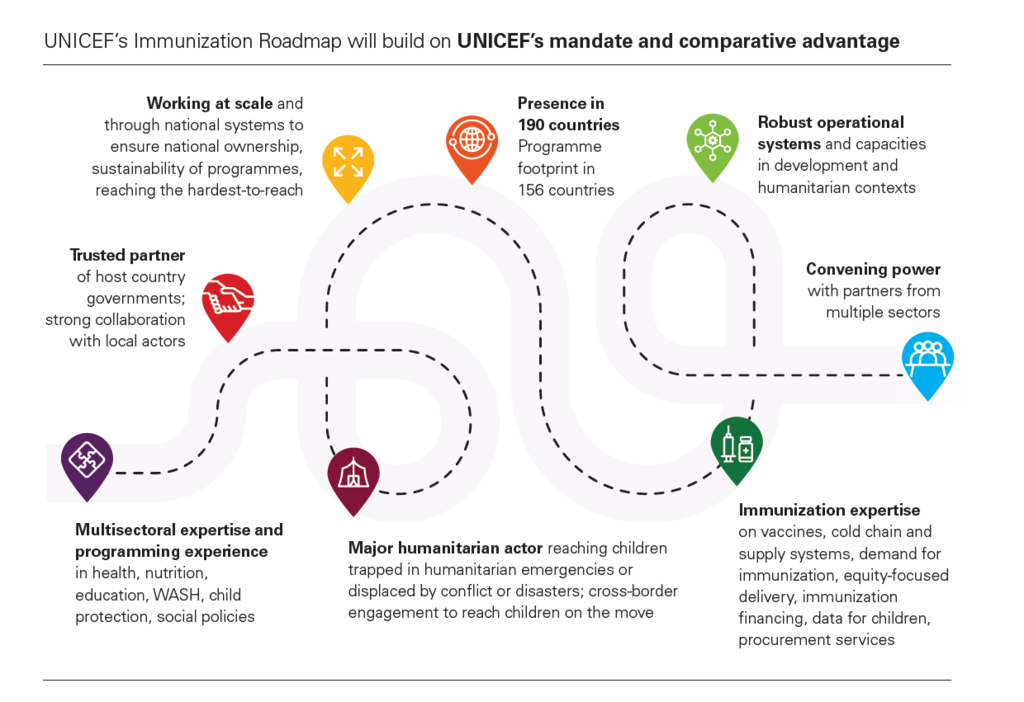Our charity partner - The Vaccine Fund
A gift that lasts a lifetime.

That’s six people, every minute, for five decades.
Today, UNICEF reaches almost half of the world’s children under five with life-saving vaccines each year.
Vaccination provides children with benefits that can last their lifetimes. It is not only the safest protection from deadly diseases – vaccinated children grow up stronger and do better at school, with economic benefits that ripple sustainably across whole communities.
All while being incredibly cost effective and delivering a
return on investment of at least €20 for every €1 spent.

Support The Vaccine Fund

Challenges
Despite these longstanding benefits, we are currently witnessing the largest sustained backslide in childhood vaccination rates in three decades.
Violent conflicts, displacement, pandemic-related disruptions, and vaccine misinformation have cut children off from routine immunisations.
Some 25 million children are now missing out on life-saving vaccines every year, placing them at risk of preventable diseases like measles and polio.
Diseases like these do not recognise borders.
What is the Vaccine Fund?
The Vaccine Fund is a unique opportunity to pool your resources with other UNICEF supporters to maximise your impact for children by helping us reach every child with lifesaving vaccines.
We encourage you to be ambitious and become a part of UNICEF’s vision for a world where no child will die or suffer from a preventable disease.
UNICEF’s work for children is completely voluntary funded, and therefore relies entirely on vital contributions from our supporters.
UNICEF’s Approach
As the largest single vaccine buyer in the world, UNICEF procures more than 2 billion doses of vaccines annually for routine childhood immunisation and outbreak response.
In over 100 countries, we work with governments, businesses, non-governmental organisations, and other UN agencies to engage communities, procure and distribute vaccines, keep supplies safe and effective, and facilitate affordable access for even the hardest-to-reach families.
Vaccine delivery is just one aspect of our work in this field. UNICEF also invests in strengthening community health systems to improve supply chains, data systems and disease surveillance – helping more children receive the protection they need.
Vaccinating every child also means investing in new approaches with the promise of ensuring sustainable, equitable funding and a pipeline of game-changing vaccines and cutting-edge technologies.
Key statistics on how UNICEF acts as a vaccine-provider / procurer
- UNICEF is recognised as the largest single buyer of vaccines globally, conducting large-scale procurement for routine immunisation, outbreak response and preventive campaigns.
- Vaccines are one of the most cost-effective interventions; UNICEF notes that over the past 50 years, immunisation has saved an estimated 154 million lives.
- UNICEF delivered 2.787 billion vaccine doses to 99 countries in 2024—enough to reach about 45 % of the world’s children under age 5.
- Of those in 2024, 652.7 million doses were delivered specifically to support disease-outbreak responses in 39 countries.
- UNICEF supported 24 vaccine introductions in country immunisation programmes in 2024 — this included the introduction of the malaria vaccine in 15 countries.
- In 2024, UNICEF delivered 37.5 million doses of HPV vaccine to 50 countries.
- UNICEF’s forecast accuracy for vaccines in 2024 remained above 98% — indicating very high precision in estimating quantities needed.
- Beyond vaccines alone, in 2024 UNICEF also procured 1,500 solar systems to power cold-chain equipment, supporting the solarisation of ~450 health facilities by mid-2025.
- As part of its role in the global pandemic response: in 2021, UNICEF delivered more than 884 million vaccine doses for the COVAX initiative and other programmes; in the same year it procured about 2.3 billion routine vaccine doses.
- Challenge: Routine global immunisation coverage stalled in the early 2020s and UNICEF is working to recover these numbers in the past 5 years.
